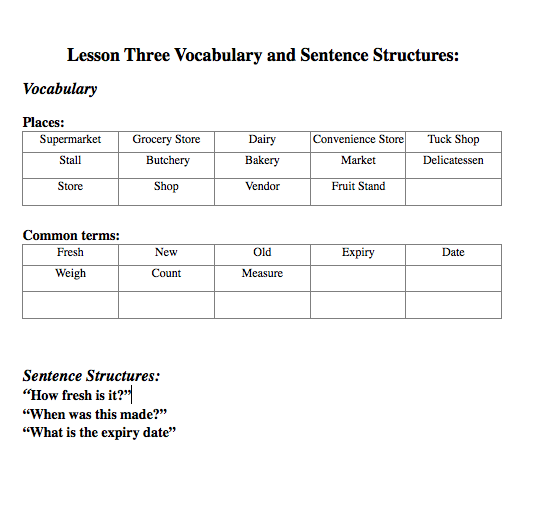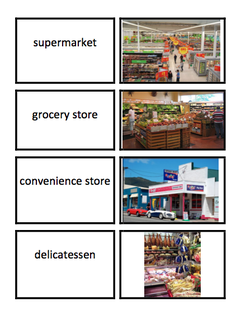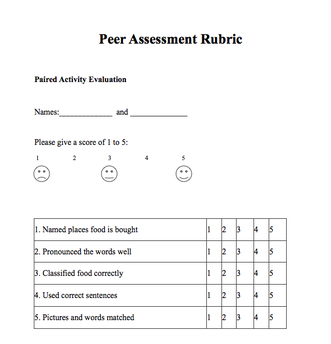Lesson Three
|
Learning Intention: Students will develop English language skills used to shop for basic foods in different environments.Students will demonstrate developing knowledge of vocabulary and sentence structures through a reflective journal. |
WALT (We Are Learning To):
1. Identify, name and pronounce the names of the different places where we go shopping for food.
2. Classify the food we buy according to where we buy them from e.g. bread in bakery.
3. Monitor our own progress in this unit by recording reflections and evaluations in an on-going journal.
Success Criteria
We know we will have achieved this when:
1. We can name and correctly pronounce six or more places where food can be bought.
2. We can accurately sort food items into places where they may be bought.
3. We have recorded reflective journal entries and scores in our journal as indicated during each lesson.
Contents
[hide]Learning Journal
(i) Students head up Lesson Three sub heading in learning journal. Teacher model and write on board for students to copy.
(ii) Students record WALT and Success Criteria under Lesson Three.
Vocabulary
|
Vocabulary and Sentence Structures The following are the vocabulary and sentence structures used in this lesson: |
http://www.familylobby.com/common/tt6115628fltt.gif Students get copy of printed vocabulary for Lesson Three and glue into Learning Journal.
Review
Play the 4-3-2 game where learners stand in two lines facing each other, and have a given amount of time to say a sentence with vocabulary learnt in the last lesson, or use the expressions learnt, appropriately while the other line listens. So the other row are the speakers and the other row are the listeners. They swap roles when they finish. The time is reduced as they master the vocabulary and expressions, hence 4-3-2. This could be used as an introductory activity for several lessons.
Extension Activity: Visit the following website for a variety of picture match activities based around food vocabulary: vocabulary.co.il
Activity One
Task i
Using visuals (pictures, photos and word cards) teacher introduces the new vocabulary and expressions. Use the audio file or teacher models how to pronounce the words and say the expressions with children imitating.
Media:Lesson 3_Common_places1.swf Media:Lesson3_Common_places2.swf Media:Lesson3_Common_places3.swf
Task ii
Using all the vocabulary of food stuffs learnt from the previous lessons, the class discuss where they can buy them in their community.
Teacher writes the name of places to go shopping on the board. The teacher gets the students into groups and they have to come to the board in their groups and write what food they could by at those places. Each team has one place to write the words under. They have to use all the vocabulary words learnt in previous lessons. The teacher should encourage the students to go beyond the words learnt in previous lessons and write down any new words they know.
http://www.familylobby.com/common/tt6115628fltt.gif After the students sit down the teacher goes through the vocabulary on the board and corrects any mistakes and also gets the students to write in their learning journal any new words that they don’t know.
Activity Two
Learners practice saying the vocabulary and expressions to one another. They come back and present what they have done to the class. (Encourage comments from other learners).
Activity Three
Using vocabulary learnt about where they can buy different foods, students make a diagrammatic presentation of these places and foods that are bought there. This may be done on a computer or by hand eg, Powerpoint could be used or learners could create a collage of cut out pictures of items purchased in their chosen market e.g. vegetable market, butchery, farmers market, fish shop etc. The focus is on the oral language component of this so students will need to present or discuss this activity when completed with their peers.
http://www.familylobby.com/common/tt6115628fltt.gif Students glue in collage, printed Powerpoint or copy of other activity completed above, into Learning Journal.
Reflection
Groups/Individuals present their activity from Activity 3 to the class. The focus is on the oral language component so that students are encouraged to practice the vocabulary and sentence structures. Other students will give feedback to the speaker/s by using the Peer Assessment Rubric in the Assessment Section of this Lesson. Students should be encouraged to focus their feedback on the criteria outlined in the Rubric which will make up a section of each students overall assessment for this Lesson.
Assessment
Learning Journal
Conduct a vocabulary test the same as lesson two.
Formative
Ongoing teacher formative assessment of students. Teacher questions and reviews student progress providing formative feedback for individuals. Formative activities should be conducted across a range of whole class, group and individual activities regularly throughout the lesson. Feedback may be written or oral and may or may not be recorded for future reference as deemed appropriate by the teacher.
http://www.familylobby.com/common/tt6115628fltt.gif Teacher records on-going formative assessment comments in Learning Journal.
Rubric
Peer assessment rubric for the paired and group activity:
http://www.familylobby.com/common/tt6115628fltt.gif Students glue completed Peer Assessment Rubric into Learning Journal.


